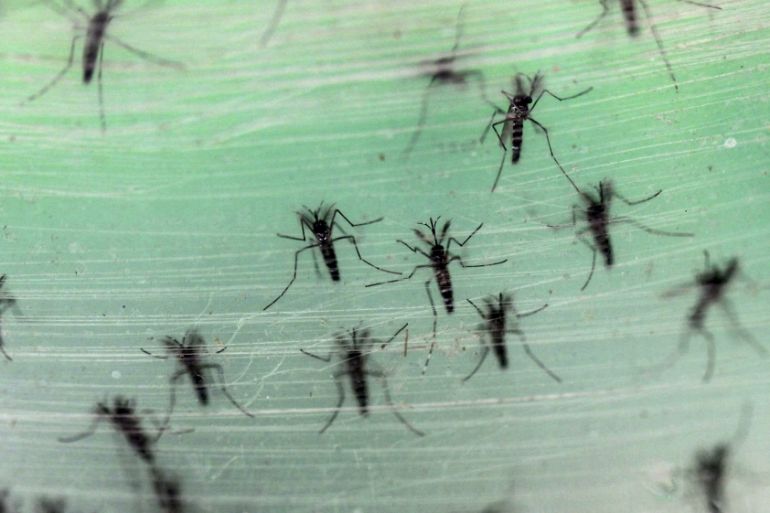Europe set to suffer as climate change brings mosquito threat
Millions more people could be exposed to mosquito-borne diseases in coming years amid global warming, experts say.

A new study has predicted that climate change will result in millions more people, especially in Europe, being exposed to mosquito-borne diseases in the coming decades.
Two of the world’s most dangerous mosquitos – Aedes aegypti and Aedes albopictus – are known to thrive in warm climates, spreading viruses such as dengue, yellow fever and Zika most effectively at between 26 and 29C.
Keep reading
list of 4 itemsAt least 155 killed in Tanzania as heavy rains pound East Africa
Scientists say Oman, UAE deluge ‘most likely’ linked to climate change
Photos: Deadly floods wreak havoc in Kenya’s capital
The mosquitos currently threaten more than a billion people globally. But scientists say that as the world warms – the expected result of climate change – they will migrate towards the poles, exposing millions more to the diseases they carry.
“We wanted to demonstrate how projected future climate change would impact the risk of spread of vector-borne disease – in this case, by two very tenacious global invaders,” Sadie J Ryan, an associate professor of medical geography at the University of Florida, told Al Jazeera.
The researchers, whose study was published last week in the PLOS Neglected Tropical Diseases journal, developed a model that allowed them to track shifting weather-warming scenarios over the next century.
With this, they were able to work out where mosquitos were likely to migrate and what effect the diseases they carry could have on people living in those regions.
“In the next few decades, nearly half a billion more people will be exposed,” said Ryan. “By 2080, that number will increase to nearly a billion, under the worst-case scenario.”
The researchers said the threat to human health would likely also come from new and lesser-known mosquito-borne diseases.
Before the Zika epidemic in the Americas in 2015-2016 – which resulted in more than 600,000 notified cases and almost 2,000 babies being born with birth defects – the disease was little studied.
Researchers at the University of Florida decided to include Zika in their modelling, as well as chikungunya, a viral disease transmitted to humans by infected mosquitoes.
“This model advances the field by providing the first mechanistic forecast for the potential future risk of chikungunya and Zika,” Maria Diuk-Wasser, an associate professor at Columbia University, told Al Jazeera.
Europe at risk
The researchers called the scale of the potential risk alarming, but the real effect of the mosquitoes’ movement only became apparent when it was mapped against human populations.
“We will see poleward expansions, [into] some of the densest populations in Europe for the first time, leading to rather rapid increases in novel exposure risks,” said Ryan.
The team said their predictions were useful as a planning tool, giving decision-makers a better idea of the risks they were likely to face and what they would need to do to monitor and control the spread of diseases in the years ahead.
“This means we can start thinking about how to allocate resources before we are surprised by the next outbreak,” said Ryan.
Added dimension to climate change
Last week, the United Nations’ weather agency reported that extreme weather in 2018 had affected 62 million people worldwide, forcing two million to relocate.
UN chief Antonio Guterres highlighted the fast-expanding cost to public health from changes to climate, including heatwaves and flooding.
The University of Florida researchers expressed hope their study will increase awareness about changing health threats and the need to act to limit rising global temperatures.
“It gives us a sense of the urgency to think about climate change mitigation in the context of global health,” said Ryan.
“It shows us that places we don’t currently associate with ‘tropical diseases’ will become at-risk areas, but also that we still can mitigate that risk through action on climate change.”
Too hot
One surprise finding from the study was that as global temperatures rise, some areas currently home to the Tiger mosquito (Aedes albopictus) will become too hot for them to thrive.
While this will have a positive effect on human health in these regions – tropical zones in Africa and the Americas, Southeast Asia – the scientists expressed concern over how the temperature changes could affect entire ecosystems.
|
|
“The fact that we start to see a decline in risk for the Tiger mosquito indicates that we face a world that is too hot for mosquitoes to transmit disease, which is itself rather an alarming signal,” said Ryan.
“I was surprised to see the degree to which this would occur in certain areas,” Diuk-Wasser said, adding that the non-linear effects of climate change on disease risk means it “poses a very difficult management challenge”,
Ryan said more work needed to be done to better understand how rising global temperatures would affect humans, animals and plants.
“Understanding how these will respond to climate change will allow us to assess our future, plan for management and control and argue for climate mitigation strategies.”